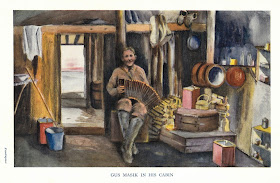
Norwich Public Library's book club visited Rauner for a session in September to take a look at materials on the development of science fiction as a literary genre. Many of Jack London's works were brought out for this session as his novels employ similar schemes that one can find in current science fiction stories, and thus are considered the predecessors of the science fiction genre. One of these works is a short story titled
Relic of Pilocene, which was first published in
Collier's Weekly Journal of Current Events in 1901. Though the story does not explicitly employ scientific inventions and technology, it does reference paleontology and its spirit of the wilderness adventure works in a similar way to the
Star Wars movie series, imaginatively exploring the unknown world. In fact,
Relic of Pilocene goes well with this volume of
Collier's Weekly in that this volume was dedicated to recapitulating technological developments of the 19th century. The articles in this volume demonstrate technological developments in many areas such as transportation and communication from 1801 to 1901.
The most remarkable page in this volume was this imaginary illustration of what the technology in 2001 would look like. Frederick Strothmann, an American illustrator known for his World War I propaganda poster "Beat back the Hun with Liberty Bonds," drew this image with a caption that says "Broadway, New York, as it may appear a hundred years hence, when modern inventions have been carried to their highest point of development." In his drawing, Strothmann includes many subtle and not-so-subtle clues about what he thinks will be commonplace at start of the 21st century.

In some ways, it seems like our technology has reached its highest point. We do have skyscrapers that loom over the skyline, and wireless telephones do allow people from across the world to stay in touch. Though not exactly identical to Strothmann's vision, floating trams do exist in underground or above-ground versions in big cities across the world. The United States doesn't have submarine lines to Europe but underwater tunnels do exist in parts of the world, like that between the United Kingdom and France. Though not by hot air balloon, people, and mail, were able to travel by air well before 2001.
At the same time, some other projections are far from accurate and, in fact, we still believe that a few of these will be realized in the future. Some people still fancy the idea of compressable food tablets that provide all the nutrition we need without having to have a full meal, and some do argue that it could be possible in the near future. Unfortunately, I'm not sure if we will ever be able to restore youth by electricity, though it sounds very tempting!
Take a look at other cool illustrations printed in this volume by asking for
London PS 3523 .O46 R45 1901.
 The nights are getting really long as we approach winter. One of the nice things about having a huge polar research collection, is that whenever our northern climate starts to wear on you, there are plenty of harrowing stories in the collection about places much colder and much darker through the winter. Today we stumbled on a northern version of A Thousand and One Nights. But in the polar regions, one month-long night will do the job for a pretty long story.
The nights are getting really long as we approach winter. One of the nice things about having a huge polar research collection, is that whenever our northern climate starts to wear on you, there are plenty of harrowing stories in the collection about places much colder and much darker through the winter. Today we stumbled on a northern version of A Thousand and One Nights. But in the polar regions, one month-long night will do the job for a pretty long story.
